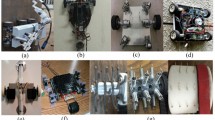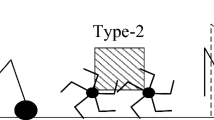Abstract
Passive dynamics is always one of research emphases of the legged robots. Studies have proved that cheetah robot could achieve stably passive bounding motion under proper initial conditions in the ideal case. However, the actual robot must have energy dissipation because of friction and collision compared with the theoretical model. This paper aims to propose a control method that can drive the cheetah robot running in passive bounding gait. First, a sagittal-plane model with a rigid torso and two compliant legs is introduced to capture the dynamics of robot bounding. Numerical return map studies of the bounding model reveal that there exists a large variety of passively cyclic bounding motions (fixed points). Based on the distribution law of fixed points, an open-loop control method including touchdown angle control strategy and leg length control strategy is put forward. At last, prototype of the cheetah robot is designed and manufactured, and locomotion experiment are carried out. The experiment results show that the cheetah robot can achieve a stable bounding motion at different speeds with the proposed control method.
Similar content being viewed by others
References
Hornby G S, Takamura S, Yokono J, Hanagata O, Yamamoto T, Fujita M. Evolving robust gaits with AIBO. IEEE International Conference on Robotics and Automation, San Francisco, CA, USA, 2000, 3040–3045.
Albiez J, Ilg W, Luksch T, Berns K, Dillmann R. Learning a reactive posture control on the four-legged walking machine bisam. IEEE International Conference on Intelligent Robots and Systems, Maui, HI, USA, 2001, 999–1004.
Kimura H, Fukuoka Y. Biologically inspired adaptive dynamic walking in outdoor environment using a self-contained quadruped robot: ‘Tekken2’. IEEE International Conference on Intelligent Robots and Systems, Tokyo, Japan, 2004, 986–991.
Hodoshima R, Fukumura Y, Amano H, Hirose S. Development of track-changeable quadruped walking robot TITAN X-design of leg driving mechanism and basic experiment. IEEE International Conference on Intelligent Robots and Systems, Taipei, China, 2010, 3340–3345.
Murphy M P, Saunders A, Moreira C, Rizzi A A, Raibert M. The LittleDog robot. International Journal of Robotics Research, 2011, 30, 145–149.
Poulakakis I, Smith J A, Buehler M. Modeling and experiments of untethered quadrupedal running with a bounding gait: The Scout II robot. International Journal of Robotics Research, 2005, 24, 239–256.
Sproewitz A, Tuleu A, Vespignani M, Ajallooeian M, Badri E, Ijspeert A J. Towards dynamic trot gait locomotion: Design, control, and experiments with cheetah-cub, a compliant quadruped robot. International Journal of Robotics Research, 2013, 32, 932–950.
Wang X, Li M, Wang P, Guo W, Sun L. Bio-inspired controller for a robot cheetah with a neural mechanism controlling leg muscles. Journal of Bionic Engineering, 2012, 9, 282–293.
Alexander R M. Three uses for springs in legged locomotion. International Journal of Robotics Research, 1990, 9, 53–61.
Raibert M H. Legged Robots That Balance, MIT press Cambridge, MA, USA, 1986.
Raibert M, Chepponis M, Brown Jr H B. Running on four legs as though they were one. IEEE Journal of Robotics and Automation, 1986, 2, 70–82.
Ahmadi M, Buehler M. The ARL monopod II running robot: Control and energetics. IEEE International Conference on Robotics and Automation, Detroit, MI, USA, 1999, 1689–1694.
Gregorio P, Ahmadi M, Buehler M. Design, control, and energetics of an electrically actuated legged robot. IEEE Transactions on Systems, Man, and Cybernetics, Part B: Cybernetics, 1997, 27, 626–634.
Li M, Jiang Z, Wang P, Sun L, Ge S S. Control of a quadruped robot with bionic springy legs in trotting gait. Journal of Bionic Engineering, 2014, 11, 188–198.
Wu Q, Liu C, Zhang J, Chen Q. Survey of locomotion control of legged robots inspired by biological concept. Science in China Series F: Information Sciences, 2009, 52, 1715–1729.
Fukuoka Y, Kimura H. Dynamic locomotion of a biomorphic quadruped ‘Tekken’ robot using various gaits: Walk, trot, free-gait and bound. Applied Bionics and Biomechanics, 2009, 6, 63–71.
Zhang J, Gao F, Han X, Chen X, Han X. Trot gait design and CPG method for a quadruped robot. Journal of Bionic Engineering, 2014, 11, 18–25.
Watanabe W, Sato T, Ishiguro A. A fully decentralized control of a serpentine robot based on the discrepancy between body, brain and environment. IEEE International Conference on Intelligent Robots and Systems, St. Louis, MO, USA, 2009, 2421–2426.
McMahon T A. Muscles, Reflexes, and Locomotion. Princeton University Press, Princeton, USA, 1984.
Raibert M H, Brown H B, Chepponis M, Hodgins J, Koechling J, Miller J, Murphy K N, Murthy S S, Stentz A. Dynamically Stable Legged Locomotion. Technical Report, Carnegie-Mellon University, Pittsburgh, PA, USA, 1985.
Neishtadt A, Li Z. Stability Proof of Raibert’s Four-Legged Hopper in Bounding Gait. New York State University, New York, USA, 1991.
Berkemeier M D. Modeling the dynamics of quadrupedal running. International Journal of Robotics Research, 1998, 17, 971–985.
Poulakakis I, Papadopoulos E, Buehler M. On the stability of the passive dynamics of quadrupedal running with a bounding gait. International Journal of Robotics Research, 2006, 25, 669–685.
Poulakakis I. On the Passive Dynamics of Quadrupedal Running. McGill University, Montreal, Canada, 2002.
Tucker V A. Energetic cost of locomotion in animals. Comparative Biochemistry and Physiology, 1970, 34, 841–846.
Author information
Authors and Affiliations
Corresponding author
Rights and permissions
About this article
Cite this article
Nie, H., Sun, R., Hu, L. et al. Control of a cheetah robot in passive bounding gait. J Bionic Eng 13, 283–291 (2016). https://doi.org/10.1016/S1672-6529(16)60301-3
Published:
Issue Date:
DOI: https://doi.org/10.1016/S1672-6529(16)60301-3




